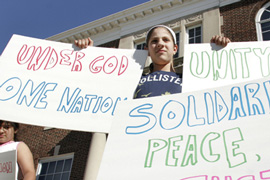Inspired by the roots of Arab unity
Former Iraqi minister revisits Arab nationalism and encourages its espousal.

 |
| Hani: The Arab League’s creation is a “safe and sure step” for unity [GALLO/GETTY] |
If history is any indication, Arab Unity is not a lost cause. It is also not an age-old cause. The roots of Arab Unity were founded in the second half of the 19th century, which was marked by frequent nationalist uprisings in the Ottoman Empire’s European territories.
Most of these uprisings, which signaled the spread of national movements across Europe, resulted in independence from the Ottomans and the emergence of new independent states based on the ethnic configuration of the area.
These events held repercussions for those in the empire’s Arab region; people there had known themselves, and the world had known them too, as “Arabs” for centuries.
But given the frequent European invasion of different parts of Arab-Islamic “countries” in North Africa, plus the emergence of the Young Turks Movement and their insistence on “Turkization” of all the nations that were left in the empire, Arab scholars and leaders had little choice but to follow course and work to achieve independence.
Promises broken
The desire for a unified independent Arab state prompted Arab leaders to join the Allies in the first world war after the negotiations of Sir Henry Mac Mahon with the late Sayyid Hussein bin Ali, the Sharif of Mecca.
 |
| Americans hold an event to express concern about divisions in the Arab world [GALLO/GETTY] |
Unfortunately, the Allies had different plans. Contrary to the assurances given to Hussein by the British, the Arab lands were divided between France and the UK.
A share was also given to Zionists, as per the 1916 Sykes-Picot Agreement, a secret treaty between British and French governments that defined their spheres of influence after the war.
Many historians and scholars today point to the agreement, which Russian press printed in 1917, as the real cause behind instability in the Middle East.
Following the war, several acts of resistance took place in the Arab lands that were now under French or British occupation.
The Great Iraqi Revolution in 1920, considered a watershed because all factions of the country united for the first time under a common effort, and various uprisings in Syria and Palestine served as examples of the Arab quest for liberty, which continued until World War II.
The Anglo-Iraqi War in 1941 and the overthrowing of the Iraqi monarchy in 1958 serve as further signs that the Arabs were struggling to achieve the unity that first prompted them to rebel against the Ottomans.
Unity not dead
It is important to note that when European forces invaded countries in North Africa, other Arab nations joined the resistance against the aggressors. A similar solidarity was seen during uprisings in the newly formed states after the second world war, and is still demonstrated to a certain extent when volunteers join resistance movements in Iraq, Palestine and Lebanon today.
In the first half of the 20th century, the call to unite the new “states” created on Sykes-Picot lines continued in Iraq, Syria, Palestine and beyond. Responding to calls for unity by Kuwaiti scholars, people held demonstrations there in the late 1930s to support uniting with Iraq.
The events of 1958 prove that unity was not only a dream, but a living reality. In February of that year, Syrians and Egyptians chose in a referendum to unite their two countries and form the United Arab Republic (UAR).
 |
| Promises that the British made to the Sharif of Mecca were broken after the first world war |
The new republic inspired popular support in different parts of the Arab world, but also attracted the enmity of many parties.
That included neighboring Jordan, which felt threatened by the state, and Britain and France, because the new republic had shown the Sykes–Picot lines could be “trespassed” and the “sacred frontiers” could be wiped.
In 1961, the union collapsed after a military coup in Damascus, funded by other Arab governments, prompted Syria to withdraw from the state.
The move was bitterly opposed by many Syrians, who demonstrated against that coup despite the force used by secessionists against them, actions that many regard as another “referendum” in support of unity.
A league of their own
The creation of the Arab League during World War II marked a new chapter in the efforts to fulfill Arab Unity. Many of the leaders who signed its “birth certificate” were known as advocates of unity – the league’s first secretary general, one of the most prominent Arabists in Egypt, was among the many Egyptian enthusiasts who had volunteered to fight against the Italian invasion of Libya at the beginning of the 20th century.
To many, the Arab League, which fosters cooperation but doesn’t promote the loss of self-rule, represented a safe and sure step on the long road to unity.
Since its inception in 1945, the league has established several important programmes, including the Organisation of Economic Unity, the Common Defence Pact, specialised organisations in transport, communications and health, and the Arab Fund for Economic and Social Development. These organisations and others, which are governed by specialised ministerial councils, could serve as effective unifying tools that help tremendously in paving the road towards a smooth union.
The call for unity is still alive, and will continue to live in the hearts and minds of Arab people, languishing at times but rekindling at every setback that confronts an Arab state.
Abdulkarim Hani is vice chairman of the Movement of Arab Nationalist Current. He formerly served in the Iraqi Ministry of Health and as a minister of labour and social affairs.